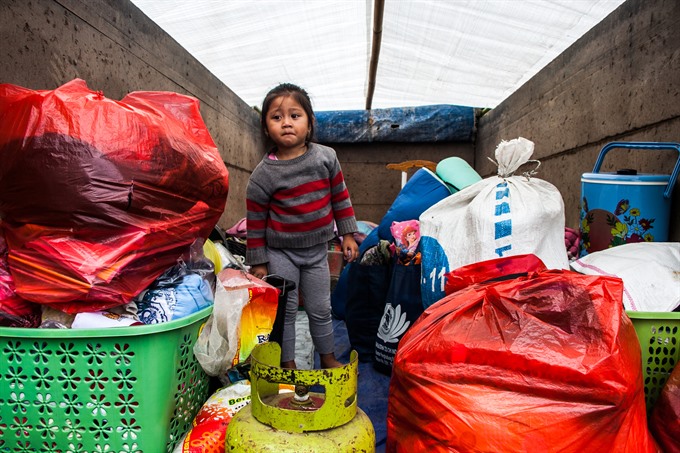 World
World

Plumes of ash from a rumbling volcano forced Indonesian authorities to close Bali's airport for a second day Tuesday, as a threatened eruption stranded tourists and forced mass evacuations.
 |
| A girl waits for her family inside a truck during the evacuation in Karangasem, Bali, Indonesia, on Monday. — XINHUA/VNA Photos |
KARANGASEM — Plumes of ash from a rumbling volcano forced Indonesian authorities to close Bali’s airport for a second day Tuesday, as a threatened eruption stranded tourists and forced mass evacuations.
Tens of thousands of frightened people have fled their homes near Mount Agung, which looms over the resort island, as experts raised the alert level to maximum and warned it could erupt at any moment.
Towering columns of thick grey smoke have been belching from the volcano since last week, and in the last few days have begun shooting into the sky, forcing all flights to be grounded until at least on Wednesday morning.
"The Volcanic Ash Advisory shows that the plane routes have been covered by volcanic ash, this is dangerous for the flights," Wisnu Darjono from the air traffic agency AirNav official said, referring to a global network of experts that supplies volcano-related information.
Some 40,000 people have abandoned their homes in the danger zone but as many as many as 100,000 will likely be forced to leave, disaster agency officials have said.
"Volcanic ash is still spewing. It’s thick and rising very high -- up to three or four kilometres from the crater," said I Gede Suantika, an official at Indonesia’s volcanology agency.
"Activity at Mount Agung remains very high. It’s still on the highest alert level," he added.
The exclusion zone around Agung, which is 75 kilometres away from the beachside tourist hub of Kuta, has also been widened to 10 kilometres.
As of Tuesday some 443 flights had been cancelled, affecting more than 120,000 passengers in Bali, a top holiday destination that attracts millions of foreign tourists every year.
The airport on nearby Lombok island -- also a popular tourist destination east of Bali -- has opened and closed several times in the past few days. It is currently open but may yet be shuttered again, officials said.
Memories of disaster
Mount Agung last went off in 1963, killing some 1,600 people in one of the deadliest eruptions ever seen in a country with nearly 130 active volcanoes.
Memories of that disaster have helped drive people towards community centres and makeshift camps, including villagers who have to leave precious livestock behind.
"I am very worried because I have experienced this before," 67-year-old Dewa Gede Subagia, who was a teenager when Agung last roared, said from one evacuation centre.
"I hope this time I won’t have to evacuate for too long. In 1963, I left for four months."
Experts said however that Agung’s recent activity matches the build-up to that disaster, which ejected enough debris - about a billion tonnes - to lower global average temperatures by 0.2 - 0.3 degrees Celsius for about a year.
"What we are seeing at the moment are small explosions, throwing out hot gases and fragments of molten rock, or ash," said David Pyle, a volcano expert at Oxford University.
"The probability of a large eruption is high, but this may take some days or weeks to unfold."
Agung rumbled back to life in September, forcing the evacuation of 140,000 people living nearby. Its activity decreased in late October and many returned to their homes.
However, on Saturday the mountain sent smoke up into the air for the second time in a week in what volcanologists call a phreatic eruption - caused by the heating and expansion of groundwater.
Then on Monday so-called cold lava flows appeared - similar to mud flows and often a prelude to the blazing orange lava seen in many volcanic eruptions.
Indonesia is the world’s most active volcanic region. The archipelago nation with over 17,000 islands lies on the Pacific "Ring of Fire" where tectonic plates collide, causing frequent volcanic and seismic activities.
Last year, seven people were killed after Mt. Sinabung on the western island of Sumatra erupted. A 2014 eruption at Sinabung killed 16. — AFP
 |
| The Mount Agung volcano spews hot volcanic ash, as seen from Rendang, Karangasem, Bali, Indonesia, on Monday. Indonesia has raised alert for Mount Agung volcano to the highest level 4, disaster management sources said on Monday. |




